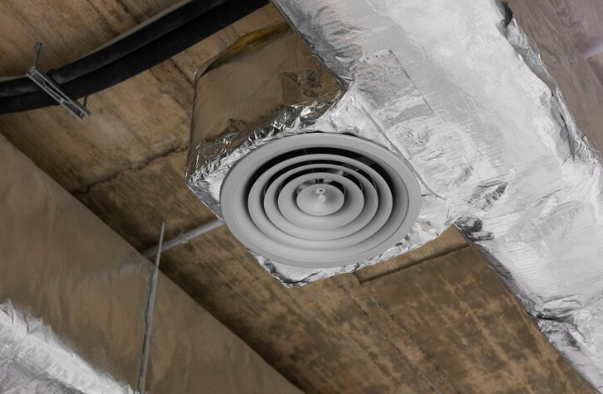Air ducts are a crucial part of your home’s HVAC system, responsible for distributing cool or warm air throughout your living space. However, duct leaks are a common issue that can compromise your system’s performance and increase energy costs.
In this blog, we’ll walk you through the process of identifying duct leaks, understanding their impact, and repairing them to improve your home’s energy efficiency.
What Are The Common Signs Of Duct Leaks In A Residential AC System?
Detecting duct leaks isn’t always straightforward, but certain signs can help you recognize potential issues early on. Here are some of the most common indicators that you might be dealing with duct leaks:
- Uneven cooling or heating: Some rooms in your home may feel significantly cooler or warmer than others, indicating air isn’t properly circulating.
- Higher energy bills: If your energy bills are rising despite consistent AC usage, your system might be working harder to compensate for lost air.
- Weak airflow from vents: A noticeable reduction in airflow from one or more vents could point to a leak in the ducts.
- Dusty or dirty air: Duct leaks can draw in dust and dirt from attics, basements, or walls, leading to poor indoor air quality.
- Noisy HVAC system: If you hear hissing, whistling, or rattling sounds when your AC is running, it could be due to air escaping through small leaks.
- Visible damage or gaps: If you can access your ductwork, check for visible holes, cracks, or loose joints that could be leaking air.
How Do Duct Leaks Affect The Performance Of An AC System?
Duct leaks can have a profound impact on the overall efficiency and effectiveness of your AC system. Here’s how they can affect performance:
- Increased energy consumption: When air leaks from ducts, your system has to work harder and longer to cool or heat your home to the desired temperature, leading to higher energy usage.
- Reduced comfort: Leaks cause uneven temperature distribution, making it difficult to maintain consistent comfort in all rooms.
- Decreased lifespan of the HVAC system: An overworked system wears out faster, shortening the lifespan of expensive components like the compressor or fan motor.
- Poor indoor air quality: Duct leaks can pull in contaminants from unconditioned spaces, circulating dust, allergens, and pollutants throughout your home.
- Increased humidity: Leaks can allow humid outdoor air into your system, which may lead to higher indoor humidity levels and make your home feel warmer than it actually is.
What Are The Methods Used To Detect Leaks In Air Ducts?
Now that you know the signs and effects of duct leaks, the next step is detecting where the leaks are occurring. Here are some of the most effective methods used by homeowners and professionals to identify leaks in air ducts:
- Visual inspection: This is the simplest method. Check exposed sections of your ductwork for visible holes, tears, or disconnected joints. Use a flashlight to inspect areas like attics, basements, or crawl spaces where ducts may be hidden.
- Feel for air drafts: While the system is running, place your hand near the duct connections or along the length of the ducts. If you feel air escaping, there may be a leak. Use a smoke pencil or incense stick to identify smaller leaks by observing how the smoke moves near suspected areas.
- Pressure test: HVAC professionals often use a pressure test to measure the amount of air loss in the duct system. By pressurizing the ducts and using specialized equipment, they can determine the exact location and extent of leaks.
- Duct leakage tester: A duct leakage tester uses a calibrated fan to pressurize the system and monitor air loss. This method provides a precise measurement of duct leakage but typically requires professional assistance.
- Thermal imaging camera: A thermal imaging camera can detect temperature variations along the ductwork. Cold spots (for AC systems) or warm spots (for heating systems) on the camera screen can indicate areas where conditioned air is leaking.
- Blower door test: Another method used by professionals is the blower door test, which measures the overall air tightness of the home and helps locate duct leaks in combination with pressure testing.
How Can Repairing Duct Leaks Improve Energy Efficiency In A Home?
Repairing duct leaks is one of the most effective ways to boost energy efficiency and enhance the comfort of your home. Here’s how it makes a difference:
- Reduced energy consumption: By sealing leaks, you prevent air from escaping, allowing your HVAC system to operate more efficiently. This leads to lower energy bills and reduced wear on the system.
- Improved temperature control: With a properly sealed duct system, conditioned air reaches every room as intended, ensuring a more consistent and comfortable temperature throughout your home.
- Extended lifespan of HVAC components: An efficient system doesn’t have to work as hard, reducing the strain on critical components like the compressor, blower, and motor. This can extend the life of your system and reduce the need for costly repairs.
- Better indoor air quality: Sealed ducts prevent contaminants from entering the air you breathe, which is especially important for households with allergies or asthma. Cleaner air also means less dust settling on your furniture and surfaces.
- Lower carbon footprint: Using less energy not only saves you money but also reduces your household’s environmental impact by lowering the demand for electricity generated from fossil fuels.
Steps to Repair Duct Leaks
If you’ve identified duct leaks, repairing them can be a relatively simple DIY task or one that requires a professional, depending on the extent of the damage. Here’s how to get started:
- Seal with mastic sealant: For small leaks or gaps, use mastic sealant, a sticky paste that hardens over time. Apply it with a brush or caulk gun around joints and seams to create an airtight seal.
- Use foil tape: High-quality foil tape is another option for sealing smaller leaks. Make sure to clean the surface of the duct before applying the tape, and smooth it out to ensure proper adhesion.
- Replace damaged sections: If sections of your ducts are too damaged to be repaired, they may need to be replaced entirely. Consult an HVAC technician if you’re unsure how to handle extensive damage.
- Insulate ducts: Once repairs are made, consider insulating the ducts to prevent future leaks and improve energy efficiency. Insulated ducts are better protected from temperature fluctuations and physical damage.
Detecting and repairing duct leaks in your residential AC system is essential for maintaining optimal performance, reducing energy costs, and improving indoor comfort. Whether you opt for DIY fixes or hire a professional, addressing duct leaks promptly can save you money and extend the lifespan of your HVAC system.
Why Horne Heating and Air Conditioning Inc. is the Best Choice for Detecting and Repairing Duct Leaks
At Horne Heating and Air Conditioning Inc., we pride ourselves on offering top-notch HVAC services, including expert duct leak detection and repair. Our team of highly trained technicians uses advanced tools and techniques to accurately locate and seal duct leaks, ensuring your system operates at peak efficiency. We understand that ductwork is a critical component of your HVAC system, and even small leaks can lead to significant energy loss. That’s why we take a comprehensive approach to inspecting, diagnosing, and resolving any issues with your ducts.
With decades of experience, we have built a reputation for reliability, quality service, and customer satisfaction. We also offer competitive pricing and flexible scheduling to fit your needs, making us the trusted choice for homeowners in the area. Whether it’s a minor repair or a complete duct replacement, we are committed to restoring your home’s comfort and efficiency. Call us today to schedule a consultation!
FAQs About Duct Leak Detection and Repair Costs
How much does it cost to detect duct leaks in a residential AC system?
The cost for detecting duct leaks can vary depending on the size of your home and the complexity of your duct system. On average, you can expect to pay between $150 and $400 for professional duct leak detection services. For more advanced methods, like thermal imaging or pressure tests, the price may be slightly higher.
How much does it cost to repair duct leaks?
The cost of repairing duct leaks typically ranges from $300 to $700, depending on the extent of the damage and the materials used for the repair. Minor repairs involving sealing with mastic or foil tape are on the lower end, while more extensive repairs or replacements can be more expensive.
Are duct leak repairs covered by warranties?
In many cases, ductwork repairs may be covered under the warranty of your HVAC system, especially if the damage is due to a manufacturer’s defect. However, it’s always best to check the details of your HVAC warranty or ask our technicians for clarification.
Ready to Improve Your Home’s Efficiency? Contact Horne Heating and Air Conditioning Inc. Today!
Don’t let duct leaks drain your energy and your wallet. At Horne Heating and Air Conditioning Inc., we offer expert duct leak detection and repair services to help restore your home’s comfort and efficiency. Call us to schedule an inspection today!













